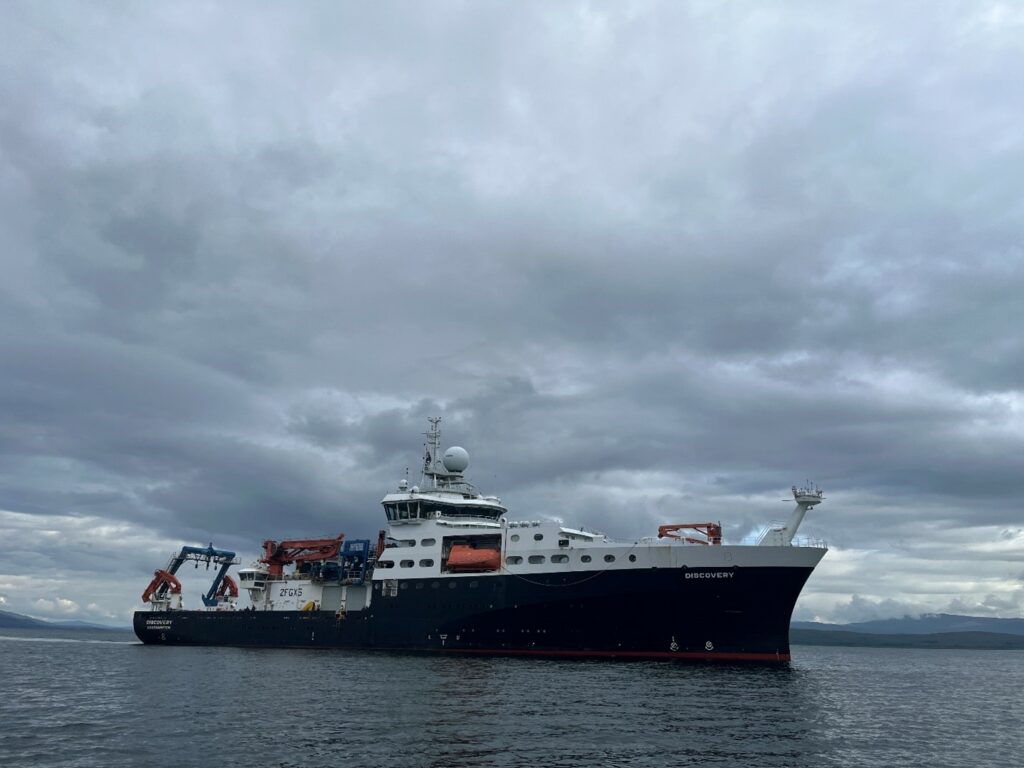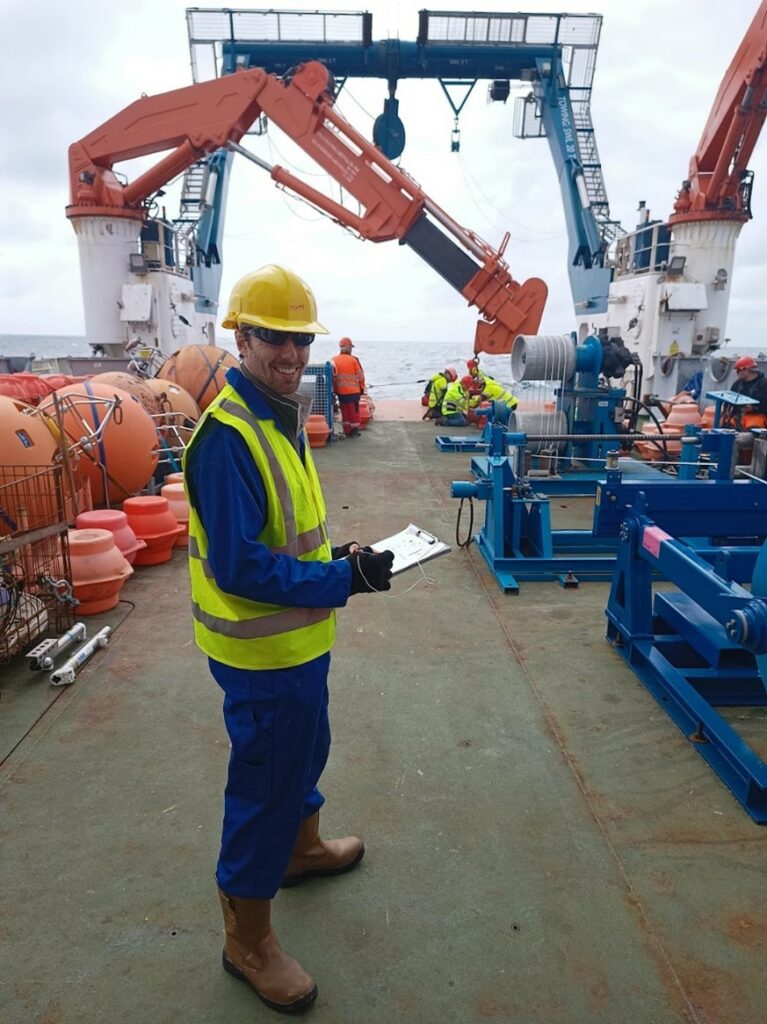
RRS Discovery before navigating the Sound of Mull, Westcoast Scottland.
The easternmost moorings of the OSNAP line are maintained by the UK project partners NOC (National Oceanography Center) and SAMS (Scottish Association for Marine Science) under the project AtlantiS. 2024 is a special anniversary year, as it will complete 10 years of OSNAP raw data. For me it is very special, as it is the first time I am leading a cruise. The UK cruise DY181 on RRS Discovery started in Aberdeen, UK on 3 July and we plan to arrive in Reykjavik, Iceland on the 28 July. As part of AtlantiS, we offered berths of opportunity on our OSNAP cruises to give early career scientists the chance to gather cruise experience or take part in the cruises with their own projects. In the following weeks, the successful candidates of the programme will introduce themselves here on the blog and share their cruise experience with you. For day-to-day updates we will post regularly under #DY181 on X. I hope you will enjoy the blog!
Kristin (SAMS, UK)

Me on deck monitoring the deployment of one of our moorings
Hello there, I’m Matt! I’m a physical oceanography research scientist from the National Oceanography Centre (NOC), Southampton. On board DY181, I am one of the physics watch leads. There are 3 physics watches, but what does this mean? We have 3 teams of physical oceanographers, meaning we can maintain operations 24 hours a day. I lead the 08:00 – 16:00 watch, but there is also a 16:00 – 00:00 followed by a 00:00 – 08:00.
What do we do? Every 4 hours, we do ‘the rounds’, which involves checking all the underway (permanently running) systems we use and make sure they are operating and logging correctly. At this time, we also take a surface seawater sample. We continually pump seawater into one of our labs and pass it through temperature and salinity sensors. Taking samples allows us to do checks to see if these sensors are operating correctly, within expected ranges.
The physics watch also oversee the deployment and recovery of our CTD rosette (conductivity-temperature-depth profiler). Our wonderful technicians who operate and maintain this piece of equipment trigger Niskin sampling bottles to close at depths that the chemistry and biology teams want to sample at. After the technicians hand over the data files from the CTD, the physics watch then process the data. While we do have some code that automates most of the process, we do have to manually tag any measurements that look like electrical noise.
We also help out the moorings team by assisting with logging instrument serial numbers that are used on the moorings. Or occasionally help with carrying or cleaning the instruments.
As you can see, life on board is very varied and there’s lots to keep us busy!
Dr Matt Clark

I am Anneke, a first-year PhD candidate at NOC Southampton. At NOC, I’m in the Marine Physics and Ocean Climate (MPOC) Department. In my research, I am using satellite altimetry in combination with in-situ measurements of temperature and salinity to obtain a basin-wide estimate of volume transport of the Atlantic Meridional Overturning Circulation (AMOC) and assess how that transport might change with latitude and how those changes might impact the regional climate.
On DY181, I am part of the Physics watch. My main tasks are taking salinity samples from the CTD-casts as well as the underway sampling system and doing some initial processing of the CTD data. Interestingly (Or lazily😉), we don’t analyse the salinity samples ourselves. This is almost exclusively done by the technicians on-board. Maybe because the salinometer can be a little temperamental…
I am also the designated Marine Mammal Observer (MMO). MMOs make sure that the acoustic systems we carry on board to measure depth and plot bathymetric profiles (single-mean and multi-beam echosounders) don’t pose a risk to marine mammals, specifically the organs that allow them to do echolocation. Usually, this is not a problem as we operate the echosounders on a continuous basis so there is no sudden exposure to sound for any mammals in the vicinity. During certain science operations, however, the acoustic signals from the echosounders can interfere. This is the case during the release of moorings when recovering, or when determining the position of a mooring after deployment (ranging and trilateration), for example. In those cases, the echosounders have to be switched off and my job is to make sure they are not switched off for too long, to avoid this sudden exposure to sound of any mammals when we switch them back on again. If they were switched off for longer than 10 minutes, I’d have to keep a mammal watch on the bridge to check for presence of any mammals in the vicinity and only if there was none could we gradually switch on the acoustic systems again. Really all I do is start and stop 9-minute alarms and log the times that we switch the echosounders on and off, but everyone involved in ranging and trilateration of moorings is aware of these limitations anyway, so it is a pretty straight-forward process (hopefully I’m not jinxing it, as we still have a few moorings to recover and deploy at the time of me writing this :o). Because I am the MMO, I have been assigned to the daytime watch (just in case I did have to do a mammal watch), which comes with some perks😊 First of all, I don’t have to adjust to a nocturnal rhythm, which can be difficult (if not utterly horrifying the moment you realise you may miss out on Full English breakfast or Sunday roast :o); but it also means I can learn lots and get involved with the other science operations on-board that are usually only carried out during daylight, such as the recovery and deployment of moorings and Argo floats, which is exciting! I think this diversity might be the best part for me on this research cruise!
Anneke Sperling
One response to “RRS Discovery – DY181, Aberdeen (UK) to Reykjavik (Iceland)”